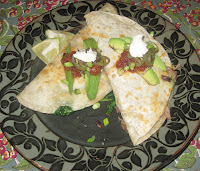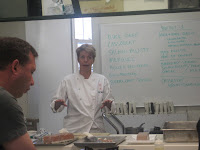
Perhaps I’m late to the table on this one, but in the last month, I’ve been pondering meat consumption in America. Dependence on choice cuts of meat for our dinner table, with a casual disregard for the rest of the animal, has proven to be totally irresponsible.
I switched to the farmers market and grass fed meats about five years ago, after Barbara Kingsolver's Animal, Vegetable, Miracle and Michael Pollan's Omnivore's Dilemna made me face the environmental issues surrounding food. I have reduced my footprint. I am a more thoughtful shopper and cook.
But, it's now time to face the Nose To Tail question, head on. I want to be responsible. I want to use the whole beast. I want to understand food preservation. There is so much to think about, and I won't step up on the soapbox too much. Just sayin', it's time to realize we're eating animals, and do right by the beasts, for heaven's sake. And respect the meat we do put on our table, putting our purchasing dollars in the hands of ethical farmers.
For some excellent reading on the subject, I recommend The Compassionate Carnivore and Fergus Henderson’s marvelous book The Whole Beast: Nose To Tail Eating.
So, with an eye toward responsibility in my carnivorous-ness, I decided to search for ways to use all those supposedly “lesser” cuts of meat. Turns out they’re not lesser at all. They’re more-er. More fat, therefore more flavor, and many, many more ways to use them.
Michael Ruhlman’s Charcuterie provided engaging reading on the subject, and his recipes are somehow approachable, even when daunting. How does he do that? I considered shoulders – lamb, pork, veal – and how they become pates and sausages. Contemplated offal, and how liver changes to terrine. And I thought about all the ancient methods of preserving – confit! proscuitto! I was thoroughly seduced.
In one of those amazing moments of synchronicity, I received an email from L’Academie de Cuisine offering a two-day class in all things charcuterie – rillettes, gravlax, confit, pate, terrine, sausage techniques, as well as accompaniments – better yet, it was a participation class, not demonstration. I signed up instantly.
Chef Bonnie Moore is a wonderful teacher, and in her element when addressing traditional French cookery. There were eight students, all accomplished cooks and serious food lovers. The foods we created under her tutelage were stellar, and the opportunity to figure out how to use that KitchenAid meat grinder under Chef’s watchful eye made the class totally valuable.
One side note, I wouldn’t recommend eating rillette, terrine, pate, confit, gravlax, boudin blanc, and merguez all in one afternoon. But how could I resist? I spent the afternoon on the couch moaning, and ate salad for the next three days.
Knowing I would forget everything if I didn’t repeat it at home, I started shopping. It was important to me that the meats were locally raised, grass fed and finished, and between several of my favorite farmers, located and ordered everything I would need. I called Paul H., a good friend, fellow food-lover, and excellent cook, and planned a day of sausage-making for the end of the month. It is definitely a two-person job. I’ll be posting about that adventure in Charcuterie: Part Two.
In the meantime, I looked around for some ducks.
Saturday morning. Broad Branch Chevy Chase Farmers Market. Four beautiful 3.5# ducks (and two pounds of duck liver!) from Smith Meadows. They were fresh-killed, flash frozen, and needed a day to thaw before I dealt with them. And Farmer Betsy Pritchard told me to enjoy those ducks – she wouldn’t be raising them again! Evidently, raising ducks is more challenging than raising chickens and turkeys - her usual barnyard critters.
I was confronted by these ducks – I was going to have to take the birds apart. While I’ve cut up many a chicken, I haven’t deboned breasts, or done any carving on a RAW bird. Always after the chicken was cooked... never really worried what the parts looked like. This was a whole new story - these duck parts needed to look dinner party pretty.
Sunday morning. In the kitchen with a super sharp knife, four ducks, and my computer. Gotta love YouTube. I have a new boyfriend – his name is Killer. He’s made an incredibly useful video on deconstructing the duck. After watching it FOUR times, I took a deep breath and started slicing. I’m really very pleased with the results. There are more photos on Flickr.
I started an enormous pot of duck stock and made the house smell gorgeous. Already planning, I know it will be perfect to fortify the Thanksgiving gravy. Wrapped and froze the breasts in pairs, ready for dinner parties. Finally, in a big bowl, I readied the confit rubbing the duck leg quarters with salt, pepper, thyme and garlic, and refrigerating for 48 hours.

I spent awhile picking the duck off the bones. It was fantastic, moist and flavorful. That night, I used it for a quesadilla, and that's the recipe I'm sharing today. Made in an instant after scrounging through the 'fridge, it was an instant hit.
Monday: I skimmed the fat from the soup. I realize this isn’t the official way to render the fat (slowly simmering fat & skin and other scraps from the butchering table until you have clear fat and cracklin’s) but it worked out beautifully. I missed the cracklin’s but my cholesterol didn’t. Skimmed off about 2.5 cups of fat. The stock went into the freezer in 1.5 qt. bags.
Tuesday: Removed the leg quarters from the garlic/herb mixture, rinsed and patted them down with a paper towel. Using my favorite Le Creuset buffet pan, in went the duck legs and fat and it started warming on the stove. I was a little worried that the legs weren't immediately submerged, but more fat rendered off the ducks, so eventually they were under the fat.
Pay attention here… this is the secret to confit success… (thank you Chef Moore!) ADD A LITTLE WATER TO THE FAT. I know, sounds crazy, right? But you don’t want the duck to FRY in the fat, you want them to poach, essentially. And as long as there is water in the fat, and steam releasing, the temperature will stay at 212•, below the frying point. Brilliant.
Confit needs to cook until the meat is falling off the bone and the fat is nice and clear - what amounts to a very long time. After the legs and fat came to a good simmer, I put the pan in a 225• oven, uncovered, for six hours. I checked every hour or so to see if the steam was still releasing, and added a little bit of water (3 Tbls?) a couple of times.
At the six hour mark, the duck looked spectacular. And the fat was clear and golden. That fat is going to make some seriously good roast potatoes.
Packed in a crockery dish, the legs submerged in fat, all of it covered with parchment paper, plastic and foil, and then frozen; this lovely duck confit will be part of a glorious, celebratory Cassoulet at a holiday party.
For now, I’ve been enjoying the shredded duck in quesadillas. I hope you do, too. (I suppose you could substitute chicken breast if you don’t have any shredded duck, but that would be a shame. I recommend cooking a duck breast just for this dish, it’s That Delicious.)
And that's my Nose To Tail tale.
Shredded Duck Quesadilla
Serves 2 for dinner or 4 for appetizers
1 c onion, sliced into thin halfmoons
2 Tbls unsalted butter
1 c shredded, cooked duck
1 tsp. chili powder
2 c micro greens, stir fry greens or baby arugula
1 c queso fresco, crumbled, or jack cheese, grated
½ c chopped fresh cherries, mango, or peach (dried, frozen or home-canned can be substituted)
4 large flour tortillas
Canola oil
Garnish (any or all):
Pickled jalapenos
Chopped scallion
Chopped cilantro
Avocado slices or Guacamole
Salsa
Lime wedges
Heat butter in a skillet and cook onions slowly until they caramelize. Set aside. In the same skillet, heat a little canola oil, toss the duck in, add the chili powder and about 1/2 c. of water. Cook until heated through. Set aside.
Heat a whisper of oil in a large skillet to medium high. I like to use my cast iron pan for quesadilla-making, but any pan will do. Add one of the tortillas and cook briefly, flipping it over a few times. You’ll start to see bubbles forming. Place one quarter of the duck, onions, cheese, fruit and micro greens on top of the tortilla.
Reduce the heat to low and cover the pan. When the cheese is melted, fold the tortilla in half and flip from side to side until it is slightly browned and gooey.
Repeat with the additional three tortillas, keeping each warm until they are all finished. Cut each quesadilla into three or four wedges and serve with the garnishes.
PS Wouldn't these be gorgeous little passed hors d'oeuvres? A 2" tortilla layered with shredded duck, queso, tiny greens, one fat sauteed cherry, a chunk of avocado.













4 comments:
I agree they would make a fabulous appetizer! What a fun post. My husband is the confit-maker in our household, but when we have it on hand, I love to play with different ways to use the meat (and fat).
I always go to Chinatown to get the Buddhist ducks. These are the whole animal with neck, head and feet intact. All the extra fat from the neck is great for rendering and the feet and bill add an incredible amount of gelatin to your stock. (Here's a nice hint learned from David Waltuck, put a bit of star ainse in your duck stock -- it's marvelous).
I have a crock of rendered duck fat in the fridge right now. There's nothing better for making croutons and, of course, garlic confit is a must! Stock is in the freezer.
For a treat in Czech fashion, I like to get some very dark, thick bread and spread the fat on it, sprinkle with salt (kosher or sea) and eat. Yum.
WOW WOW WOW I CANT WAIT!
Just bought a new kitchen aid for making sausage. Cant wait to cajole someone into helping me!
Paul H is looking forward to making pate and sausages! Duck is now on my list...
Post a Comment